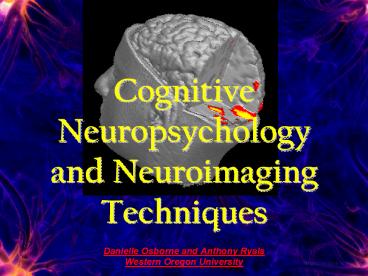Cognitive Neuropsychology and Neuroimaging Techniques - PowerPoint PPT Presentation
1 / 18
Title:
Cognitive Neuropsychology and Neuroimaging Techniques
Description:
Cognitive Neuropsychology and Neuroimaging Techniques Danielle Osborne and Anthony Ryals Western Oregon University Cognitive Neuropsychology What is Neuropsychology? – PowerPoint PPT presentation
Number of Views:645
Avg rating:3.0/5.0
Title: Cognitive Neuropsychology and Neuroimaging Techniques
1
Cognitive Neuropsychology and Neuroimaging
Techniques
- Danielle Osborne and Anthony Ryals
- Western Oregon University
2
Cognitive Neuropsychology
3
What is Neuropsychology?
- Traditionally defined, neuropsychology is the
study of brain-behavior relationships. - Pathology
4
What is Neuropsychology?
- Study of both healthy and damaged brain systems.
- Biological causes of behaviors
- From creative genius to mental illness
- Personality
Right-Hemisphere Stroke
5
Examples of Neurological diagnosis
- Dementias
- Alcohol and Drug Psychoses
- Mental Retardation
- Stroke
- Diseases of the CNS (Alzheimers, Huntingtons,
Parkinsons, Multiple Sclerosis, Epilepsy)
Alzheimers Disease
6
Functional Brain Imaging
7
EEG (Electroencephalogram)
- EEG-Electroencephalogram
- electrodes placed on the scalp detect and measure
patterns of electrical activity emanating from
the brain. - often combined with other imaging techniques
8
Transcranial Magnetic Stimulation
- Enhances or depresses activity in a specific
area of the brain. - The magnetic field produces electrical currents
in tissue. Allows the stimulation of neurons
during their refractory period. - Studies in the treatment of depression
9
CAT (Computerized Axial Tomography
- Computer analysis of brain structure
- detection of tumors, brain aneurysms, or strokes
- An X-Ray!
- Cross sections, possibly of multiple angles
10
CAT Scan of Stroke
11
PET (Positron Emission Tomography)
- Labels specific drugs or natural body compounds
like glucose with small amounts of radioactivity - can show blood flow, oxygen and glucose
metabolism, and drug concentrations in the
tissues of the working brain
12
SPECT-Single Photon Emission Computed Tomography
- Similar to PET, uses radioactive tracers to
construct two- or three-dimensional images of
active brain regions. - More limited than PET in the kinds of brain
activity they can monitor. - Much less expensive than PET
- Used in drug abuse research
13
SPECT
- Normal Brain Meth
Brain
14
MRI (Magnetic Resonance Imaging)
- It uses incredibly powerful magnets that can be
tens of thousands of times more powerful than the
Earths gravitational field. - Computer Enhancement to give three dimensional
images with exposure to radiation
15
MRI-Brain Cancer
16
fMRI (Functional Magnetic Resonance Imaging)
- Demonstrates physical changes (as in blood flow)
in the brain and mental functioning (performing
cognitive tasks) over time. - Can produce images of brain activity as fast as
every second. - Cutting-edge research.
17
(No Transcript)
18
MRI
fMRI































